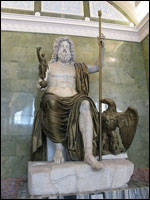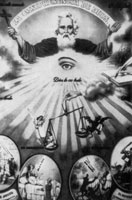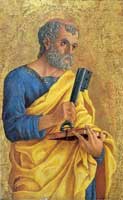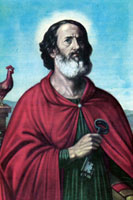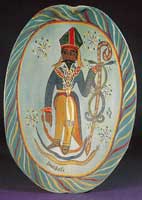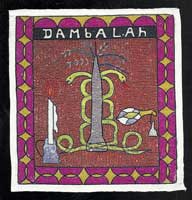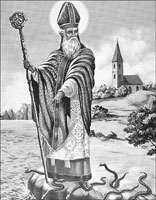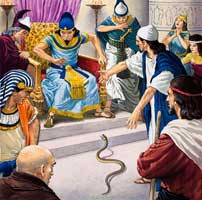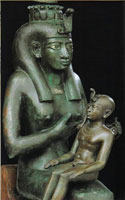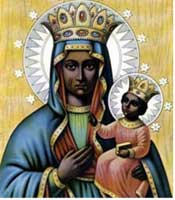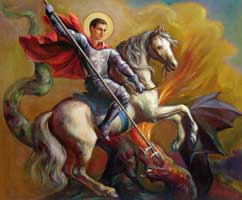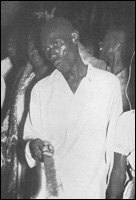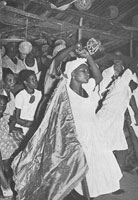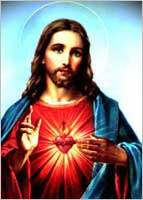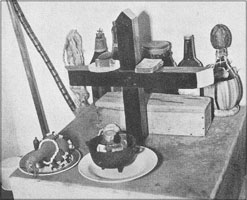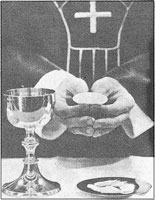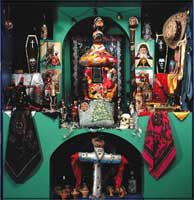FRENCH ROMAN CATHOLICISM AND AFRICAN PAGANISM MET IN HAITI TO CREATE A NEW WORLD SYMBIOSIS CALLED VOODOO!! |
The similarities between voodoo and Roman Catholicism are remarkable. After the Spanish killed all the New World natives on the island of Hispaniola, they imported slaves by the hundreds of thousands from West Africa.
Only in the New World did Roman Catholicism and African paganism merge to create the symbiosis called voodoo. Originally, all the false gods of Africa came from Egypt via Ethiopia....Before the Exodus in 1533 BC, Egyptian gods were worshipped all over Africa . . . and as far east as India.
|
Voodoo has an exact equivalent to the Latin Church Saint Peter. He is called Papa Legba, and he is associated with the keys of the underworld.
|
In 850, Pope Leo IV ordered that roosters by placed on the top of all Catholic churches to commemorate St. Peter's denying Christ 3 times. In voodoo, roosters are sacrificed to Papa Legba.
Damballah is the supreme Allada serpent divinity, associated with rain, wisdom, and fertility. He is usually depicted entwined with his wife Ayida Wèdo, the rainbow spirit.
|
Damballah is often represented as Saint Patrick . . . and Moses....Satan always looks for similarities between his religion and Christianity in order to corrupt the Gospel of Christ.
|
The real Saint Patrick did drive the snakes out of Ireland when he converted that country from paganism to true Christianity.
The Papal "bishop" Patrick is pure myth and legend because the real Saint Patrick had no connection with Roma; and the position of bishop does not exist in the Christian Congregation....Saint Patrick was an EPISCOPUS . . . and not a bishop.
The snakes he drove out of Ireland were the two-legged ones called DRUIDS who practiced diabolical human sacrifice and cannibalism.
|
Santiago and Saint George correspond to the African war loa Ogun.
|
Bizarre rituals are held to consecrate voodoo clergy. A voodoo priest is called a houngan and a priestess is called a mambo.
|
The major difference between Latin and voodoo clergy is that marriage is not forbidden to voodoo clergy, and voodoo has nothing comparable to the Latin Church's auricular confession. However, they do have to appease the offended loa by doing penance:
In order to obtain forgiveness from an offended loa Voodooists also practise various forms of external, typically mediaeval, Catholic penitence. The penitents, usually women, wear garments made of grey, so-called 'siamese', cloth or a kind of harlequin dress made of bits and pieces which correspond in colour to the various different loa; the clothes must be blessed by the bush-priest. Having sung a Mass, burnt some candles and said prayers to the saints, the penitents offer their friends and relations a grand farewell feast. Then they go out, all over the countryside, visiting in turn all the main places of pilgrimage–Saut-d'eau, Vierge du Mont Carmel, Alta Grecia, Saint Dominique–and live on public charity and on the food distributions which certain pious people dole out to acquit themselves of debts to loa or saints. They frequent the markets where they are sure to get a few sous and at least some fruit and vegetables. When they think that by their suffering and weariness they have expiated their sin in the eyes of their protecting loa they go home and resume their normal life."(Métraux, Voodoo in Haiti, p. 333).
This is almost an exact description of the career of Saint Martin Luther when he decided to save his soul by becoming an Augustinian monk!!
Almost the entire Vatican pantheon is represented in voodoo. Lenglensou basen san is the counterpart to the Sacred Heart of Jesus or le Sacré-Coeur de Jésus. Basen san means basin of blood in Creole and that is the correlation between the Sacred Heart of Jesus and blood.
|
Another diabolical practice of voodoo is human sacrifice and cannibalism, which was very common in Haiti until recent times. Since its suppression by more enlightened governments, it has just gone underground.
Cannibalism was a prominent feature of the Greek gods of antiquity. Cronus, the father of Zeus, ate 5 of his own children.
The Latin Church's practice of eating a sacrificial victim under the appearance of unleavened bread or azymes originated with the Latin Vulgate Version. In the Sermon on the Mount, the Messiah told us to pray for our daily BREAD, but the Latin Vulgate says to pray for our SUPERSUBSTANTIAL bread:
Give us this day our supersubstantial bread (Matthew 6:11, Douay-Rheims Version).
That quote is something like Zeus from Mount Olympus would say although his father Cronus tried to devour him as soon as he was born.
In 1563, the Jesuit dominated Council of Trent made belief in transubstantiation mandatory:
CANON I.-If any one denieth, that, in the sacrament of the most holy Eucharist, are contained truly, really, and substantially, the body and blood together with the soul and divinity of our Lord Jesus Christ, and consequently the whole Christ; but saith that He is only therein as in a sign, or in figure, or virtue; let him be anathema. (Canons and Decrees of the Council of Trent, Session 13, Canon I).
CANON lI.-If any one saith, that, in the sacred and holy sacrament of the Eucharist, the substance of the bread and wine remains conjointly with the body and blood of our Lord Jesus Christ, and denieth that wonderful and singular conversion of the whole substance of the bread into the Body, and of the whole substance of the wine into the Blood–the species Only of the bread and wine remaining–which conversion indeed the Catholic Church most aptly calls Transubstantiation; let him be anathema. (Canons and Decrees of the Council of Trent, Session 13, Canon II).
Here is a statement about the mass and demon possession by a French expert on voodoo:
Catholic communion is considered by certain Voodoo priests as a sacrament which increases their powers; sometimes they recommend it to their clients. Even further: some loa are regarded as Catholics and by virtue of this fact must communicate from time to time. This is notably the case with Damballah-wédo; when the god feels the need to approach the Holy Table, he tells one of his servants who then prepares himself, as a good Christian, to take the sacrament and when the day comes, putting a stone sacred to Damballah in his pocket, goes and kneels before the altar; at the very moment of taking communion he is possessed by Damballah who communicates in his place. A woman of Jacmel who was more or less a Voodooist told me that one Sunday during Mass she noticed signs of strange excitement in one of her neighbours. She watched her and realized that she had Damballah in her head. This woman went up to communicate and it was only at the moment when she got back to her place that she frankly abandoned herself to trance. While she was being removed from the church the loa inside her kept calling out: "They were saying I couldn't communicate; well I have."(Métraux, Voodoo in Haiti, p. 332).
The logical conclusion to the dogma of transubstantiation; and almost beyond belief, is that the Vatican has turned her devotees into Cannibals for Christ!!
The voodoo statement of "faith"
The most commonly held voodoo beliefs can be summarized by the following creed:
I believe in Bondye, the Almighty Father of the sky, who manifests his spiritual nature in me; in a large number of spirits; and in all things visible and invisible.
I believe in the lwas, the gods of Africa, and all the saints of the Catholic Church. Masters of the universe, they are manifestations of Bondye, who see all things and direct the course of all things; that some have made themselves known to us through our ancestors in Africa, and that others we have come to know, emulate, and serve in our new home in Haiti; that these lwas are potent enough to mount us, their children, in spirit possession; and that through their mounting, they can inspire us as to the needs of our community; that our moral duty is to faithfully serve them; that the lwas are capable, like us, of gentleness and mercy, but also of anger and revenge.
I believe in the power of ancestors who watch over us and serve us before the lwas; that they must be remembered and served faithfully.
I believe in the right granted to us by the lwas to interfere through magic in the normal flow of events as established by Bondye's will; in the efficacy of the medicines derived from the local fauna endowed to us by the lwas. I believe in the Holy Roman Catholic Church, in the communion of saints, and in life everlasting. (Desmangles, The Faces of the Gods, Vodou and Roman Catholicism in Haiti, p. 63).
No wonder JEHOVAH gave this final warning to his people:
And I heard another voice from heaven, saying, "Come out of her, my people, that ye be not partakers of her sins, and that ye receive not of her plagues" (Revelation 18:4).
References
Desmangles, Leslie G. The Faces of the Gods: Vodou and Roman Catholicism in Haiti, University of North Carolina Press, Chapel Hill, 1992.
Deren, Maya. Divine Horsemen:The Living Gods of Haiti. McPherson, New Paltz, New York, 1983.
Métraux, Alfred. Voodoo in Haiti. (Translated by Hugo Charteris). Schocken Books, New York, 1972.
Rigaud, Milo. Secrets of Voodoo. City Lights Books, San Francisco, California,1953.
Copyright © 2020 by Patrick Scrivener
